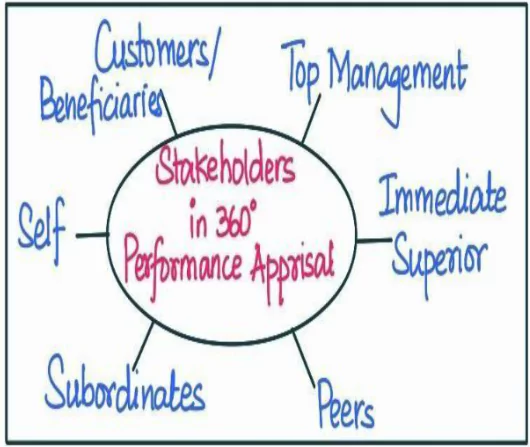Answer:
|
How to approach the question
- Introduction
- Write about 360-degree performance evaluation briefly.
- Body
- Write the strengths of the 360-degree performance evaluation mechanism as a tool for ensuring accountability.
- Write the weaknesses of the 360-degree performance evaluation mechanism.
- Write the potential areas of improvement in this regard.
- Conclusion
- Give appropriate conclusion in this regard
|
Introduction
The 360-degree performance evaluation was introduced in 2015 to supplement the existing system of Annual Confidential Reports for civil servants and incorporates assessment from multiple perspectives ensuring a holistic appraisal fostering integrity, accountability, transparency, and fairness.
Body
Strengths of the 360-degree performance evaluation mechanism as a tool for ensuring accountability

- Comprehensive Assessment: For example, a civil servant’s interactions with colleagues, responsiveness to public grievances, and adherence to ethical standards can be assessed through different perspectives.
- Fairness and Impartiality: For instance, if a civil servant consistently exhibits ethical conduct but faces criticism from a superior, the inputs from other sources can balance the evaluation.
- Encouraging Ethical Behaviour: For instance, if a civil servant consistently demonstrates honesty and transparency in financial matters, this would be reflected in feedback from peers and subordinates.
- Multi-dimensional Feedback: For example, if a civil servant receives constructive criticism about their communication skills from subordinates, they can work on enhancing their effectiveness in conveying information.
- Performance Alignment: For instance, if the organizational value system emphasizes public service and responsiveness, feedback from external stakeholders can highlight any deviations or failures in meeting those expectations.
- Enhanced Team Dynamics: It encourages collaboration, cooperation, and mutual support. For example, if feedback reveals a lack of cooperation from a civil servant, it can prompt discussions and interventions to improve team dynamics.
- Performance Recognition: The 360-degree mechanism also allows for the recognition and reward of exemplary performance, further reinforcing accountability and encouraging their dedication, professionalism, and commitment to ethical conduct
Weaknesses of the 360-degree performance evaluation mechanism
- Lack of clarity and subjectivity: It may lead to personal biases and favouritism influencing the assessment. Like if an officer holds a personal grudge against a subordinate, he may provide a biased assessment.
- Inconsistent standards: For instance, one evaluator may focus on administrative skills, while another may emphasize leadership qualities. This inconsistency undermines the objective of a fair and transparent evaluation process.
- Mutual back scratching and collusion: For instance, if two officers have a close friendship, they may give each other excessively positive ratings without proper justification.
- Fear of retribution and lack of anonymity: For example, an officer may hesitate to provide critical feedback about a superior’s misconduct for fear of jeopardizing their own career.
- Limited scope of feedback: It primarily focuses on feedback from colleagues and subordinates, neglecting inputs from external stakeholders such as the public.
- Time-consuming and resource-intensive: It requires significant time and resources to collect and analyze feedback from multiple sources. This can lead to delays in evaluations and a drain on administrative resources.
- Bias towards popularity over performance: This bias can lead to undeserving individuals receiving favorable evaluations, while those with superior performance but less popularity may be overlooked.
Potential areas of improvement in this regard
- Clear Ethical Guidelines: Establish clear ethical guidelines and standards through CVC for evaluating performance, emphasizing integrity, transparency, and impartiality.
- Inclusion of Stakeholder Feedback: Engaging citizens, NGOs, and beneficiaries of government schemes to evaluate the impact and effectiveness of civil servants. For example, it can include inputs from citizens’ feedback portals like MyGov.
- Robust Performance Metrics: Develop comprehensive and objective performance metrics that measure both quantitative and qualitative such as efficiency, effectiveness, responsiveness, and adherence to ethical standards.
- Independent Evaluation Committee: Establish an independent committee comprising experts from diverse fields, including ethics, governance, and social responsibility, to review and assess the performance evaluations.
- Performance-linked Incentives: Link performance evaluations with incentives, such as promotions or bonuses, to motivate civil servants to maintain high ethical standards.
- Public Disclosure of Performance Evaluation Reports: Making non-confidential parts of performance evaluation reports publicly available would create a sense of public trust and allow citizens to hold civil servants accountable.
- Feedback Mechanism: Establish a feedback mechanism to gather suggestions and inputs from civil servants themselves on how to improve the performance evaluation process.
Conclusion
Through adopting these measures, the 360-degree performance evaluation mechanism in the Indian civil services can become a powerful tool for fostering accountability, integrity, and ethical behaviour among civil servants, ultimately benefiting the public and society at large.
To get PDF version, Please click on "Print PDF" button.


Latest Comments